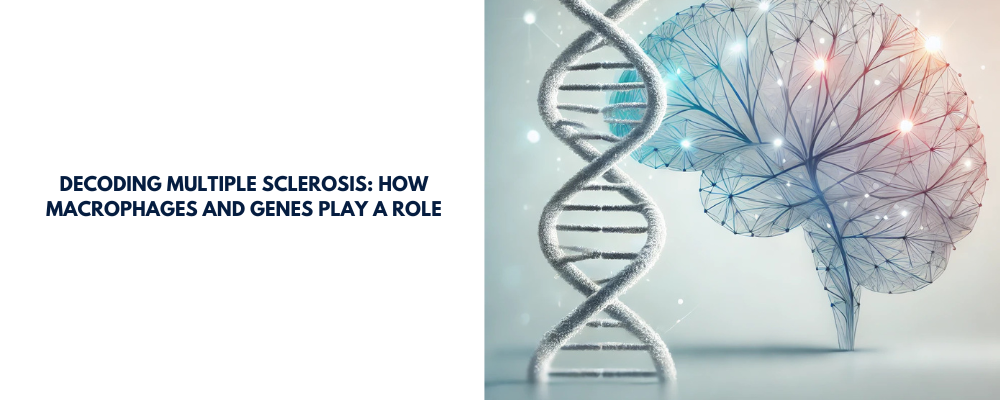Decoding Multiple Sclerosis: How Macrophages and Genes Play a Role

Multiple sclerosis (MS) is a complex, immune-mediated, and neurodegenerative disease that affects the central nervous system (CNS). It’s characterized by inflammation, demyelination (damage to the protective coating of nerve fibers), and axonal damage. Understanding the complex mechanisms that drive MS is a major challenge, but recent research is shedding light on the critical roles of specific immune cells and genes. This post dives into a recent review that explores the interplay between macrophages and HLA class II alleles in MS, aiming to uncover new possibilities for treatment.
The Immune System's Role in MS
At its core, MS involves the immune system mistakenly attacking the body’s own tissues, particularly the myelin sheath surrounding nerve fibers. This autoimmune response is driven by autoreactive T-cells, which are activated when they recognize myelin antigens. Antigen presentation, where immune cells display these antigens to T cells, is a crucial step in this process, and macrophages are key players here. Macrophages are a type of immune cell that express Major Histocompatibility Complex class II (MHC II) molecules on their surface. These MHC II molecules present antigens to T-cells, initiating an immune response.
Macrophages: More Than Just One Type
Macrophages are not a uniform group; they have different activation states and functions. The "old school" classification of M1 and M2 macrophages is an oversimplification, as these cells exist on a spectrum of phenotypes.
* M1 macrophages are pro-inflammatory and are often associated with the onset and progression of MS. They contribute to inflammation and tissue damage.
* M2 macrophages, on the other hand, are involved in tissue repair and dampening inflammation. However, even the M2 classification is complex, with subtypes like M2a, M2b, and M2c, each playing unique roles.
In MS, a pro-inflammatory profile, driven by M1 macrophages, is the primary instigator of the disease pathology. The balance between M1 and M2 macrophages is critical, and disruptions in this balance contribute to the disease.
HLA Genes and MS Risk
Genetic factors also play a significant role in MS. The Human Leukocyte Antigen (HLA) genes, located within the Major Histocompatibility Complex (MHC), are highly variable and influence how the immune system recognizes antigens. One particular allele, HLA-DRB1*15:01, has been identified as a high-risk allele for MS, particularly in Caucasian populations. This allele increases the affinity to myelin basic protein (MBP) epitopes. The structural features of HLA-DRB1*15:01 influence the way it binds to and presents myelin antigens. This is because of the unique alanine residue at position 71 (DRβ71), which creates a large, hydrophobic pocket that increases the affinity to myelin peptides. The binding of MBP to HLA-DRB1*15:01 can lead to inappropriate immune responses.
Other HLA alleles such as DRB1*03:01, DRB1*08, DRB1*16, and DRB1*11 have also been implicated in the development of MS, with some playing a protective role. For example, the DRB1*01:01 allele has a protective role by binding non-classical myelin peptides, resulting in lower binding rates. The specific way these HLA alleles interact with myelin proteins and influence immune cell activity is still being investigated.
How Macrophages and HLA Interact in MS
The link between macrophages and HLA alleles is crucial in MS. Macrophages express MHC II, and therefore, the HLA-DRB1 genotype can affect their inflammatory patterns. Specific HLA alleles, such as DRB1*15:01, can contribute to a pro-inflammatory environment by activating antigen-presenting cells (APCs) and CD4+ T cells. Furthermore, the expression levels of MHCII can be impacted by the HLA-DRB1*15:01 allele, which has been associated with grey matter lesions.
The interplay between macrophages and HLA alleles is not limited to the periphery; it also occurs within the CNS.
* Perivascular macrophages (pvMΦ) and choroid plexus macrophages (cpMΦ), which are found at the interfaces of the CNS, have high MHCII levels, which suggests their strong link to HLA function.
* Microglia, which are resident immune cells of the CNS, generally have lower MHCII signatures but can still be affected by HLA differences.
The Blood-Brain Barrier (BBB) and Immune Cell Entry
The BBB is a protective barrier that regulates the passage of molecules into the CNS. In MS, the BBB can be disrupted, allowing immune cells to infiltrate. This is an important step, as when macrophages are recruited from the circulation into the CNS, they are activated and produce high levels of pro-inflammatory cytokines, sustaining inflammation. This is thought to be facilitated by adhesion molecules, such as ICAM-1 and VCAM-1. Moreover, the choroid plexus (CP), which is the structure that produces cerebrospinal fluid (CSF), is also a site of immune cell entry and inflammation in MS. The CP has a high presence of HLA-DR activity and various MHCII+ cell populations that can cause a continuous cycle of inflammation.
Current and Potential Therapies
Current therapies for MS include disease-modifying treatments (DMTs) that aim to reduce inflammation and slow disease progression. Some DMTs, like interferon-beta (IFN-β) and glatiramer acetate (GA), have been shown to modulate the immune response and affect macrophage polarization.
* IFN-β can reduce inflammatory stress in MS. Interestingly, the effectiveness of IFN-β can be influenced by HLA alleles, with some studies showing increased responsiveness in DRB1*04 carriers.
* Glatiramer acetate (GA) is a synthetic molecule that resembles myelin basic protein (MBP) and can bind to MHC II, modulating the immune response. It promotes a shift towards anti-inflammatory phenotypes in immune cells.
However, there is a need for more targeted therapies that can directly address the underlying mechanisms of MS, such as the role of high-risk alleles like HLA-DRB1*15:01. Understanding the molecular basis of how these alleles influence immune cell activity will be key to developing new treatments.
Future Directions
This review highlights the complex interplay between macrophages and HLA class II alleles in MS. Further research is needed to fully elucidate the molecular mechanisms involved and to develop more effective and personalized treatments. This includes investigating:
* The specific ways in which different HLA alleles modulate macrophage polarization.
* The role of epigenetic factors, such as DNA methylation and histone modifications, in regulating HLA gene expression.
* The potential of targeting specific macrophage subtypes to restore immune balance and promote myelin repair.
* How the M2 spectrum and subtypes play a role in resolution of neuroinflammation.
By unraveling these intricate pathways, we can move closer to developing precision medicine approaches for managing neurodegeneration in MS and other autoimmune diseases.
Reference:
Prapas, P., & Anagnostouli, M. (2024). Macrophages and HLA-Class II Alleles in Multiple Sclerosis: Insights in Therapeutic Dynamics. International Journal of Molecular Sciences, 25(13), 7354.
